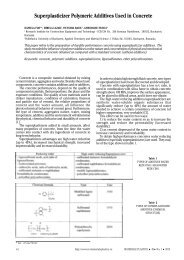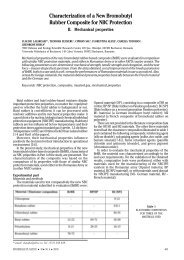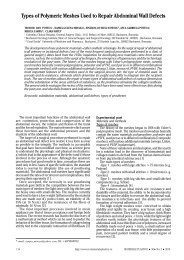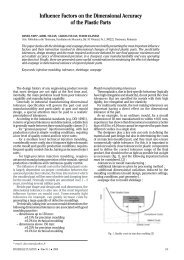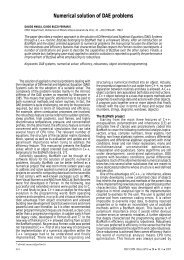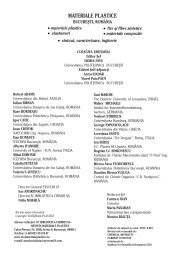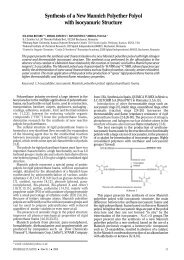L MIRCI - revista de materiale plastice
L MIRCI - revista de materiale plastice
L MIRCI - revista de materiale plastice
You also want an ePaper? Increase the reach of your titles
YUMPU automatically turns print PDFs into web optimized ePapers that Google loves.
MATERIALE PLASTICE ♦ 44 ♦ Nr. 4 ♦ 2007
typical combined roles as a plasticizer and heat stabilizerin PVC compounds. ESO, however, sometimes causessurface contamination of PVC compounds becausesaturated fatty acids such as stearic and palmitic acids insoybean oil easily bleed into surface. In addition, someingredients in ESO with hydroxi<strong>de</strong> groups and unreacteddouble bonds during epoxidation, also tend to increasethe bleeding of ESO. This is due to their low compatibilitywith PVC resins. In this study a novel plasticizer of PVCresins like glycidyl ethyl hexyl phthalate was synthesizedand its performance was evaluated with the purpose toovercome the <strong>de</strong>ficiencies mentioned above. Thisplasticizer was <strong>de</strong>signed to act as normal phtalicplasticizers and also to act as a heat stabilizer like ESO.Through the addition of epoxy groups in phtaliccompounds, the resistance to bleeding was improved, andthe plasticizing and heat-stabilizing effects in PVCcompounds were preserved. The mechanical properties,thermal stability and bleeding properties of the films wereinvestigated [11].In the same synthesis direction of esters with a mixedstructure (that is: asymmetric) the realization of some citricesters by using alcohol mixtures was reported. In this waya new type of additives, which belong to the class ofplasticizers that are a<strong>de</strong>quate for a large variety of polymers,was obtained. The alcohol mixture is <strong>de</strong>fined as Nacol typefatty alcohols. LINPLAST 46 HCT showed compatibility withPVC [12].An interesting concept regarding the plasticizer domain,is reported by a japonese patent. In this work thementioned plasticizers are manufactured from polyhydricalcohol (I)-alkylene oxi<strong>de</strong> (II) adducts with I/II molar ratio1/3-1/15, and monocarboxylic acids. The example provi<strong>de</strong>dclaims the use of an ester of octanoic acid with an glycerinethyleneoxi<strong>de</strong> 1:8 adduct, ester used to plasticize a methylmethacrylate-butyl methacrylate copolymer. Thus, 100parts of the mentioned copolymer was knea<strong>de</strong>d with 100parts plasticizer to give a paste, which was cast on a glasssheet to give a sheet showing no bleeding before and afterstorage at 50 0 C and relative humidity 95% for 14 days, shaperecovery 91% after stretching 50% in the longitudinaldirection, and good impact absorbing property [13].The plasticization of some special polymers, likepoly(lactic acid) (abbreviation PLA), by the help ofoligomeric malonate ester ami<strong>de</strong>s, constitutes the subjectof a paper which reports the <strong>de</strong>creasing of the glasstransition temperature of films resulted by compoundingPLA polymer with the mentioned plasticizers [14]. Twooligomeric malonate ester-ami<strong>de</strong>s and an oligomericmalonate ester were synthesized. The synthesis wasperformed by reacting di-ethyl-bis hydroxymethyl malonate(abbreviation DBM) with adipoyl dichlori<strong>de</strong> and one of twodiamines, i.e. triethylene glycol diamine (TA) andpolyoxypropylene glycol diamine (PA), or triethylene glycol(TEG), giving three plasticizing agents <strong>de</strong>noted as DBMATA,DBMAPA and DBMMAT, respectively. The synthesizedproducts were characterized by size exclusionchromatography and Fourier transform IR spectroscopy,and blen<strong>de</strong>d with PLA at a concentration of 15 wt%.Dynamic mechanical analysis, differential scanningcalorimetry and tensile testing were used to investigatethe physical properties of films from the resulting blends.All three plasticizers <strong>de</strong>creased the glass transitiontemperature of PLA, and the largest <strong>de</strong>crement wasobserved for PLA/DBMATA. Films of DBMATA and DBMATshowed enhanced flexibility in strain at break as comparedto neat PLA. Subsequently, it was found that thermalannealing of the plasticized materials (4h at 100 0 C)384encouraged cold crystallization, inducing phase separationin the blends and caused them to regain the brittleness ofneat PLA. On the other hand, by aging (6 weeks) the blendsat ambient conditions, cold crystallization could be avoi<strong>de</strong>dand the flexibility of the films maintained [14].In a Chinese patent the realization of plasticizers thathave excellent compatibility with polyvinylbutyral resins isreported. Thus, aliphatic dicarboxilic acid bis(alkoxydietylene glycol) esters with the general formula:R(OCH 2CH 2) 2OOC-(CH 2) n-COO-(CH 2CH 2O) 2R, where R =C1-10 alchyl and n = 4-6, were obtained. Such compoundsshow low volatility and can be used as plasticizers [15].Japanese researchers report the realization of someester type plasticizers with a complex structure which showa low level of volatility, possess bio<strong>de</strong>gradability characterand present also a <strong>de</strong>creased bleeding out. By using suchplasticizers in or<strong>de</strong>r to plasticize polyester compositions,the films obtained un<strong>de</strong>r these conditions show a goodtransparency. The plasticizers with acetylation ratio ≥ 50%comprise acetic esters of polyhydric alcohol-alkylene oxidadducts. Thus, a composition containing polylactic acid(Lacea H 440) and 20 phr plasticizer prepared by reacting1.1 mol glycerol with 11 mol ethylene oxi<strong>de</strong>, then with 1.6mol acetic anhydri<strong>de</strong>, was extru<strong>de</strong>d into 1 mm thick sheet,showing tensile strength 13.2 MPa, tensile modulus 14.9MPa (JUS K 7113) and a weight loss 0.3% after storing at50 0 C for a week [16].The literature review of the very last period of timepermits to withdraw some very interesting conclusions.Though many remarks are recor<strong>de</strong>d referring to the mostused plasticizer in the field of PVC processing, which is di-2 ethyl hexyl phthalate (DOP), especially in connection withits assigned cancerous activity (very difficult to prove,however), and it is currently suggested to replace it byvegetable-oil based plasticizers, at least in the field of foodpackaging and food-contact materials [17], many studieswhich <strong>de</strong>al with the synthesis of DOP un<strong>de</strong>r optimumconditions and by using catalyst systems more and moreperforming are reported [18]. The suggested catalyst wasTiSiW 12O 40-Al 4(SiW 12O 40) 3/ TiO 2-Al 2O 3. This catalyst showedmany advantages, for example it <strong>de</strong>crease the corrosionof equipment and the pollution in the environment, andhas higher esterification activity and selectivity. Thetreatment of products is simplified and the catalyst maybe used repeatedly. The reaction conditions recommen<strong>de</strong>dwere the following: molar ratio of alcohol to anhydri<strong>de</strong>2.25:1; the amount of catalyst 1.78% related to the alcoholand acid anhydri<strong>de</strong> mass; the reaction temperature 150 0 Cand the reaction time 2.5 h [18].Another team of Chinese researchers suggested the useof a nano solid superacid SO 4-2/ Fe 2O 3catalyst for thesynthesis of di-2ethyl hexyl phthalate [19]. The nano solidsuperacid SO 4-2/ Fe 2O 3was prepared un<strong>de</strong>r specificconditions, and its catalytic activity for the synthesis of DOPwas studied and was compared to the catalytic activity ofnormal SO 4-2/ Fe 2O 3, SO 4-2/ TiO 2, SO 4-2/ ZrO 2and H 2SO 4. Atthe same time, the factors affecting the esterificationprocess, such as the manner of the catalyst synthesis, thedosage of the catalyst and the esterifying time, were studiedand the optimum synthetic conditions were obtained. Theappropriate conditions were as follows: weight of thecatalyst was 2.8g (weight of phtalic anhydri<strong>de</strong> wasequivalent to 1.0 mol), molar ratio of 2-ethyl hexanol tophtalic anhydri<strong>de</strong> was 2.5:1, reaction time was 2.0h,reaction temperature was 150 0 C. The yield of the ester wasover 99.1%. The catalyst could be used many times withoutany treatment and without any pollution action on theenvironment. Comparing with normal catalysts, the nanoMATERIALE PLASTICE ♦ 44 ♦ Nr. 4 ♦ 2007
solid superacid catalyst had obvious advantages [19].In the same way it is reported the synthesis of di-2 ethylhexyl sebacate by using a solid superacid catalyst of SO 4-2/TiO 2-Al 2O 3type. Un<strong>de</strong>r optimum conditions, the productyield reached 98.5% using the mentioned catalyst [20].Exxon firma suggests the use of nonyl alcohols lessbranched in or<strong>de</strong>r to synthesize a<strong>de</strong>quate plasticizers.Thus, less branched C9 alcohols are used to provi<strong>de</strong>plasticizer trimellitate esters particularly suitable for hightemperature applications such as wire and cableinsulations. These less branched plasticizers are moreeconomical compared to current commercial products[21].The synthesis of diisopentyl maleate plasticizer wasperformed by using an aminosulfonic acid catalyst, throughthe esterification of maleic anhydri<strong>de</strong> with isopentanol.Un<strong>de</strong>r optimum conditions the product yield reached 93.7%[22].Since di-isononyl phthalate (DINP) became thecompeting rival of di-2 ethyl hexyl phthalate (DOP), basedon more or less solid reasons, many studies are reportedin which a quantitative <strong>de</strong>termination of DINP in PVCplastics is attempted. The proposed method, i.e. the partialleast square method, was applied un<strong>de</strong>r specificcircumstances. The linearity of the studied sample curvesis very good, with the correlation coefficient of 0.9999. Thismethod is simple, reliable, rapid, free of the influence ofthe substrates and suitable for the quality control of lineproduction [23].The realization of bio<strong>de</strong>gradable plasticizers constitutesan actual problem of large interest, this domain beingconstantly explored. Consistent reviews are reported [24],in some instances being suggested more or less ingenuoussolutions, like the one which claims the possibility to obtainbio<strong>de</strong>gradability properties by mixing 10-25% plasticizerswith 60-85% starch [25].The world-wi<strong>de</strong> concern referring to the disposal ofdifferent waste material in the surrounding, the effect ofchemistry on nature, is expressed in numerous studies,for instance the influence of lubricants on globalenvironment is reviewed [26].In the research frame exposed in the preamble of thispaper are inscribed, as we have already mentioned,different approaching alternatives such as the synthesis ofsome adipates based on 3-(4’-methylcyclohexyl) butanol.It was stated, exactly within the spirit of our researches,that the di [3-(4’-methylcyclohexyl) butyl] adipate presentsa low pour point and can be used as either lubricant orplasticizer for thermoplastics [27].Japanese scientists report the realization of a syntheticester lubricating base oil for refrigeration <strong>de</strong>vices obtainedby esterification of a mixed alcohol and a mixed carboxylicacid, in which the ester has a hydroxyl value of ≤ 5.0 mgKOH / g an acid value of ≤ 0.05 mg KOH / g and a kinematicviscosity of 30-1500 mm 2 /s at 40 0 C. The mixed alcohol iscomposed of 65-99.95 mol % pentaerythritol and 0.05-35mol % dipentaerythritol; the mixed carboxylic acid iscomposed of 25-55 mol % of a C5-C8 monocarboxylic acid45-75 mol % isononanoic acid (especially 85.50-99.95 mol% 3,5,5 trimethyl hexanoic acid). The lubricating composedis suitable for a refrigeration unit using a chlorine–freehydrofluorocarbon [28].The possibility to obtain a refrigerator lubricating baseoil, in the same direction of investigation, is reported. Thebase oil comprises mainly synthetic esters prepared byreacting pentaerythritol having carbonyl value of ≤ 50µmol/g with saturated C4-C18 fatty acid to obtain the esterproduct having Na content ≤ 100 ppm and ash contentMATERIALE PLASTICE ♦ 44 ♦ Nr. 4 ♦ 2007≤ 0.02% wt%. The pentaerythritol ester base oil is superiorin lower <strong>de</strong>gree of coloration, high thermal resistance andlubricity [29].Grease base oil is realized also by some Japaneseresearchers. Thus, the base oil contains ester of trivalentalcohol with fatty acid or trimethylol propane with fatty acidand has a viscosity of ≤ 9000 mPa.s at -40 0 C, a pouringpoint of ≤ -40 0 C, a volatilization volume of ≤ 35% wt %after heating at 180 0 C for 500 h, and a viscosity in<strong>de</strong>x of≥130. The product has excellent lubricity, especially at lowtemperatures [30].As regards our specific frame of investigation one canmention the researches performed by some otherscientists, such as by Gryglewicz et.al [31-33], which havereported the results of studies accomplished on thesynthesis and biosynthesis of adipic and sebacic esters withbio<strong>de</strong>gradability character and consi<strong>de</strong>red as base oils.As a result of our attempting approach in or<strong>de</strong>r to analyzethe results published in the last period of time by thespecialty literature, we have succee<strong>de</strong>d to <strong>de</strong>fine moreproperly our specific way of investigation. We havereported a series of results obtained un<strong>de</strong>r thesecircumstances, the latest referring to the sebacic esters[34].In the same way we have started the present study withthe aim to realize asymmetric (or unsymmetrical) adipicdiesters by using alcohols with a complex structure of analiphatic-aromatic type, namely 2-phenoxyethanol, 2-[(osecbutyl)phenoxy]ethanol and 2-[(p-nonyl) phenoxy]ethanol, respectively, in conjunction with aliphatic alcoholswith short and long chain, such as n-butanol, n-hexanol,2-ethyl-hexanol, iso<strong>de</strong>canol and isotri<strong>de</strong>canol.The adipic diesters built un<strong>de</strong>r these circumstances are<strong>de</strong>fined by the general formula (I):R 1OOC-(CH 2) 4-COOR 2(I)where:R 1= n-butyl, n-hexyl, 2-etyl hexyl, iso<strong>de</strong>cyl andisotri<strong>de</strong>cyl radicalR 2= radical with the following structure <strong>de</strong>fined by thegeneral formula (II):where R 3= H, o-sec-butyl and/or p-nonyl.By taking into account the complex alcohols with anaromatic-aliphatic structure, three groups of asymmetricadipic diesters have been synthesized.Through the analysis of the structures promoted by thegeneral formula (I) it is possible to observe an evi<strong>de</strong>ntcomplexity characteristic of compounds, in which thepolyfunctionality and asymmetry are obvious. Thus,besi<strong>de</strong>s the existence of esteric groups, which respondmainly to the promotion of the compatibility characteristicswith the base polymer, can be also remarked the presenceof some etheric bridges of an alkyl-aryl type whichintensifies the same character. The polarizable aromaticcycle may increase, to a certain extent, this feature. Thealiphatic pendant chains on the aromatic ring may producemore perturbance of the molecule symmetry, becoming asupplemental asymmetry factor, besi<strong>de</strong> that one inducedby the lack of symmetry of the consi<strong>de</strong>red adipic ester.This fact results from the use of an alcohol with aprogressive increasing chain length as a co-esterificationpartner.(II)385
Un<strong>de</strong>r these circumstances, there are provi<strong>de</strong>d sufficientvariables in or<strong>de</strong>r to allow to obtain a large interval of valuesboth as for the intrinsic physico-chemical characteristicsof the <strong>de</strong>rivatives themselves, and as referring to thespecific properties of a processing polymer aid and/or of atribological lubricant.Depending on the ratio of the polar to the non-polarfunctions, one may record either plasticizer qualities orlubricant ones, features which can be turned to goodaccount especially in the polyvinyl chlori<strong>de</strong> processing,which still represents the most important example in thefield.In the case of <strong>de</strong>rivatives which contain a large quantityof alkylic-chain, one may ren<strong>de</strong>r profitable the specificproperties of fluids which can be used in the tribologicaldomain. The results of these researches were publishedboth in the country [35] and abroad [36].Experimental partThe alcohols used for the realization of the asymmetricadipic esters present a complex structure of an aliphaticaromaticnature, and they were synthesized by using aspecial ethoxylation alternative, namely through thereaction of 1,3 dioxolan-2-one (ethylene carbonate) withthe a<strong>de</strong>quate phenols, according to our procedurespatented and published previously [37].The principal physico-chemical values recor<strong>de</strong>d forthese complex alcohols are the following:2-phenoxy-ethanol; molecular formula C 8H 10O 2;molecular mass, M = 138; <strong>de</strong>nsity, d = 1,109 g/cm 3 ;20refractive in<strong>de</strong>x, n D= 1,5370.2-[(o-sec-butyl)phenoxy]ethanol, molecular formulaC 12H 18O 2; molecular mass, M = 194; <strong>de</strong>nsity, d = 1,0164 g/cm 3 20; refractive in<strong>de</strong>x, n D= 1,5175.2-[(p-nonyl)phenoxy]ethanol, molecular formulaC 17H 28O 2; molecular mass, M = 264; <strong>de</strong>nsity, d = 0,978 g/cm 3 20; refractive in<strong>de</strong>x, n D= 1,5113.The aliphatic alcohols used: n-butanol, n-hexanol and2-ethyl-hexanol were pure samples and they were provi<strong>de</strong>dby Merck; and iso<strong>de</strong>canol and isotri<strong>de</strong>canol by BASF(Germany), respectively.The synthesis of the unsymmetrical adipic diesters wasperformed in a solution esterification process, using p-toluensulfonic acid as catalyst, the water being extractedazeotropically by means of a solvent (usually toluene),according to our similar (standard) procedures formely<strong>de</strong>scribed [38], and in conformity with an elaboratedstoichiometry, on the basis of a precisely establishedmethod for this particular case [39].The synthesized and purified adipic diesters werecharacterized by chemical and physical indices specificto this class, while the tipical properties which <strong>de</strong>fine thepolymer processing aids were <strong>de</strong>termined in accordancewith the standardized testing techniques in the field. Thus,the dynamic viscosity was measured by means of aRheotest <strong>de</strong>vice, RV type (VEB Prüfgeräte-Werk, Medingen/ Dres<strong>de</strong>n), the critical solving temperature (the TCScriteria, or KLT, Kritische Lösung Temperatur, nachThinius)was <strong>de</strong>termined by the use of a Boetius microscopeequipped with a heating plate, on a suspension PVC, Kw= 67. The gelifying power was recor<strong>de</strong>d with the help of aBraben<strong>de</strong>r plastograph, PL/3S type, using the standardreceipt, that is PVC (suspension) Kw = 67 (100 : 3) p;plasticizer (50 : 3) p; stabilizing agent basic: lead stearate(0,6 : 3) p; rotation speed 50 rot/min; 50 cm 3 vat; measuringdomain (1 : 5) . 5; temperature 160 0 C.In or<strong>de</strong>r to realize the sheet out of which the test-pieces(samples) were punched for the <strong>de</strong>termination of the386performance and efficience properties, the standardreceipt was used, namely: PVC (suspension), Kw = 67,100 p; plasticizer, 50 p, stabilizing agent: Ba-Cd stearate, 2p; the mixture was processed (rolled-laminated) on a minirollduring 5 min, at 160 0 C, friction coefficient 1 : 1,2. Thesamples for the tensile strength test were realized by usinga punching die according to SR EN ISO 2898-2:2003. Thesamples for the <strong>de</strong>termination of the performance levelwere round with a 5 cm diameter.The lubrication number was calculated on the basis ofthe Bötner-Rosenthal relationship (equation):where:C L= lubrication number,E = total quantity of ingredients expressed as procentageof the PVC quantity,T = temperature of the vat, 0 C.m D= the minimal couple, Kg.m,The values of the minimal couple were extracted fromthe Braben<strong>de</strong>r plastogram recor<strong>de</strong>d on the same <strong>de</strong>vice,with the difference that for this essay an a<strong>de</strong>quate receiptwas used, that is: PVC (suspension) Kw = 67, 100 p; tribasiclead sulphate (stabilizer without any lubricating effect), 2p; lubricant 1 p; the amount of the receipt was reduced atthe level of 30 p PVC, using the vat of 30 cm 3 , the domain5; rotation 30 rot/min, and at a temperature of 160 0 C.The flash (flammability) point was measured accordingto ASTM D 92 and the pour (flow) point according to ASTMD 97.Note. In or<strong>de</strong>r to facilitate the reading of tables and makeeasier the i<strong>de</strong>ntification of products and reading of tables,a coding system was used involving an abbreviationprinciple for the respective diesters. Thus, 2-phenoxyethanolis i<strong>de</strong>ntifiable as FE (phenol-ethoxylated); 2-[(osecbutyl)phenoxy]ethanol as OSECBUT; 2-[(p-nonyl)phenoxy]ethanol as p-N. Similarly, n-butanol is <strong>de</strong>scribedas BUT, n-hexanol as HEX, 2-ethylhexanol as 2EH,iso<strong>de</strong>canol as IZO 10 and isotri<strong>de</strong>canol as IZO 13.Accordingly, the following unsymmetrical adipic diesterswere obtained: (A) BUT-p-N, HEX-p-N, 2EH-p-N, IZO 10-p-N and IZO 13-p-N; (B) BUT- OSECBUT, HEX- OSECBUT, 2EH-OSECBUT, IZO 10-OSECBUT and IZO 13-OSECBUT; (C) IZO10-FE and IZO 13-FE.Results and discussionThe main chemical and physical indices of theseunsymmetrical adipic diesters are presented in table 1.The analysis of the data inscribed in this table permits towithdraw the following consi<strong>de</strong>rations:- the molecular mass presents values ranged within aninterval of 378 and 574 mass units. The values recor<strong>de</strong>dshow that these realized compounds are placed into amiddle category between the classical (standard)plasticizers with a relatively small molecule, such as di-2ethyl-hexyl adipate (DOA) or di-2 ethyl-hexyl phthalate(DOP), and polymer plasticizers, which consist especiallyof polyesters with a larger molecular mass;- <strong>de</strong>nsity constitutes another parameter which expressesthe variability of the realized structures, a remarkablecorrelation being ascertained. Thus, within the frame ofeach group a <strong>de</strong>crease of the values was recor<strong>de</strong>d as thechain length of the consi<strong>de</strong>red aliphatic alcohol increases.The comparison of the groups with one another, alsoreflects the influence of the structure upon the <strong>de</strong>nsityvalues. One may observe the fact that the <strong>de</strong>rivatives builton the basis of the alcohol with an aliphatic-aromaticstructure but without an alkyl pendant group on the arylMATERIALE PLASTICE ♦ 44 ♦ Nr. 4 ♦ 2007
Table 1VALUES OF THE MAIN PHYSICAL AND CHEMICAL CONSTANTSnucleus, present the highest <strong>de</strong>nsity values; these values<strong>de</strong>crease as a substituent with a progressive length isintroduced on the aromatic ring. The remarkablesuccession of this parameter certifies, on the one hand,the validity of the theoretical structures suggested, and, onthe other hand, emphasizes the high level of purity of theproducts;- the refractive in<strong>de</strong>x follows in all respects a similarvariation. At this point one can notice that this parameteris able to present different values, i.e. it is in a position todiscern or to differentiate the products even in the situationof a variation of 2-3 carbon atoms, by having in view thatwe <strong>de</strong>al with complex molecules and relatively large ones,which contain between 24 and 36 carbon atoms;- the values of the dynamic viscosity are generally smallfor all the terms of these groups. It is difficult to establish adistribution rule of the values in the case of this parameter.It is obvious that the multitu<strong>de</strong> of functions induces thischaracter but one may say that especially those of aliphaticand aromatic type, manifest the most pregnant influenceswith a reciprocal reverse effect;Note. The viscosity in<strong>de</strong>x values, which is an importantparameter in terms of <strong>de</strong>fining the attributes of atribological fluid, are placed around a value of 100, aremarkable level of performance, such results werereported in our previous paper regarding the lubricityproperties within the frame of tribological features of theseunsymmetrical adipic diesters [36].In or<strong>de</strong>r to proceed to <strong>de</strong>fine the processing polymeraids properties, either as a plasticizer or as a lubricant, thecalculation of the values of the solubility Hil<strong>de</strong>brandparameter δ, is <strong>de</strong>sirable. Even if this criterion is notinstituted as a measure (in<strong>de</strong>x) of compatibility, it offers,however, an indication in this sense, being consi<strong>de</strong>red apredictor parameter.The values of this parameter calculated on the basis ofsmall constants and on the main physico-chemicalMATERIALE PLASTICE ♦ 44 ♦ Nr. 4 ♦ 2007* Slow crystalization ten<strong>de</strong>ncy in timecharacteristics, are presented in table 2, according to thecalculation method provi<strong>de</strong>d by the literature [43]. For abetter un<strong>de</strong>rstanding the aspects revealed by thisparameter, the δ values of PVC and of the mostrepresentative primary and secondary classicalplasticizers, that is for DOA and DOP, are also mentioned.The analysis of the data inscribed in this table, permits toobserve a very close value level to that of the standardsamples. Many values are even better than that of DOP,and all are better than the DOA value. From this point ofview one may admit that the anticipated compatibility levelwould be plainly superior to DOA and close to DOP. Withinthe framework of each group, the δ values <strong>de</strong>crease asthe length of the aliphatic alcohol used increases. Thisaspect means a reduction of the compatibility which is fullyexplicable by the fact that the polarity level implicitlydiminishes.The effective level of compatibility was estimated bymeasuring the critical solving temperature, the TCScriterion, and by <strong>de</strong>fining the gelification capacity whichwas evaluated from the maximum couple values of theBraben<strong>de</strong>r plastogram and also by the shape of theregistered curve itself.The values of these measurements are presented intable 3. From the data inscribed in this table, as regardsthe TCS criterion, results a secondary plasticizer characterfor the quasi-all tested terms, with the exception of the izo10-FE example which presents a primary plasticizer TCSvalue. However, the maximum couple values indicate asuperior compatibility level which is similar to that ofprimary plasticizers at least for the terms without an alkylpendantchain (series FE) and also for those diesters builton the basis of OSECBUT, that is an isobutyl rest whichmeans a relatively short aliphatic chain,. The shapes of theeffective curves recor<strong>de</strong>d by the Braben<strong>de</strong>r plastographare in a position to establish with no doubt the plasticizingcharacter, either as primary or as secondary. On the basis387
Table 2HILDEBRAND δ SOLUBILITY PARAMETER VALUES, CALCULATED ONTHE BASIS PHYSICO-CHEMICAL CHARACTEISTICS AND SMALLCONSTANTSHil<strong>de</strong>brand δ solubility parameter,[cal/cm 3 ] 1/2of these registered plastograms one may observe that allterms of series p-N and the last term of OSECBUT seriesbelong to the secondary plasticizer class with shapes quasisimilarto that of DOA, while the rest of terms, that is seriesOSECBUT and FE, present curves similar to that consi<strong>de</strong>redfor a primary classical plasticizer, that is DOP.The second <strong>de</strong>fining attribute which is taken intoconsi<strong>de</strong>ration in or<strong>de</strong>r to establish the qualities of a polymerprocessing aid is represented by the efficiency criterion.The data that express this criterion are registered in table4, that is the Shore hardness and the results <strong>de</strong>rived fromthe tensile strength test. One must mention the fact that inthis table only the values of the terms which have permittedto extract a sheet from the mixing mill are presented; theterms izo 13-p-N and izo 13-OSECBUT, which possess alarge quantity of alkylic chain, did not permit this fact,indirectly proving a reduced compatibility level butimplicitly suggesting aptitu<strong>de</strong>s for the lubricants domain.One can observe that the tensile strength (at break)presents very good values in<strong>de</strong>ed, much better than thoseof the standard samples consi<strong>de</strong>red, while the elongationat break are almost equal with those of DOA and DOP. The100% modulus values are in some cases very good an<strong>de</strong>quivalent with those of DOA (excellent in this sense), inanother cases the values are much poorer.The Shore hardness values are comparable with thoseof DOP for the groups (series) with a reduced amount ofalkylic pendant chain on the aromatic nucleus (seriesOSECBUT and FE), while the terms of the group p-N presenta higher level of hardness, which means an adverseefficiency.Fig. 1. Braben<strong>de</strong>r plastograms for gelificationpower <strong>de</strong>termination388MATERIALE PLASTICE ♦ 44 ♦ Nr. 4 ♦ 2007
Table 5PERMANENCE CRITERIONFig. 2. Braben<strong>de</strong>r plastogram for lubricant number<strong>de</strong>termination390MATERIALE PLASTICE ♦ 44 ♦ Nr. 4 ♦ 2007
Table 6LUBRICATION NUMBER, AT 160 o Cprocessing or as tribological lubricants.Firstly, one may remark the very low values of the pour(flow) points which are below -42 0 C (in fact a level due tothe minimum cooling capacity of the testing <strong>de</strong>vices),aspect that constitutes a particularly valuable feature. Onecannot record a significant variation of these values as afunction of the consi<strong>de</strong>red structure.Secondly, the flash point presents, generally, valuesabove 200 0 C, a slight increase with the increase of themolecular mass being recor<strong>de</strong>d. This parameter is alsoable to certify an optimum level which is in a position torecommend the use of these products in differentapplicable directions.ConclusionsOn the basis of the polyfunctionality and asymmetryprinciples, series of unsymmetrical adipic diesters wererealized by taking into account special alcohols with acomplex aliphatic-aromatic structure, namely 2-phenoxyethanol,2-[(o-sec-butyl)phenoxy]ethanol, 2-[(p-nonyl)phenoxy]ethanol, respectively, along with aliphaticalcohols with an increasing chain length, that is n-butanol,n-hexanol, 2-ethyl-hexanol, iso<strong>de</strong>canol and isotri<strong>de</strong>canol.By relying on these principles and <strong>de</strong>pending on therealized structures, one may study both the progressiveincrease effect of the alkyl chain brought in by the aliphaticalcohol and the influence of the aliphatic-aromatic alcoholnature on the whole characteristics of this class ofcompounds, consi<strong>de</strong>red able to be used as polymerprocessing aids.On the basis of polar to nonpolar fraction ratio, it becamepossible to record either typical plasticizer properties,primary or secondary ones, or lubricant features, bothattributes being entitled to suggest the use of these<strong>de</strong>rivatives especially for polyvinylchlori<strong>de</strong> processing.In the case of estimating the possibility to turn to goodaccount the plasticizing properties, the recor<strong>de</strong>d valueslevel of the compatibility, efficiency and permanencecriteria, lie within the specific performance interval.The usefulness of this class of compounds in thetribological lubricant domain, was certified by specificanalyses for this field of investigation, while the results ofthese attempting approaches were presented in differentinternational congresses and were also published inspecific journals.This class of unsymmetrical adipic diesters representsa priority, not being previously reported in the literature,and the intrinsic structure, the synthesis conditions andMATERIALE PLASTICE ♦ 44 ♦ Nr. 4 ♦ 2007also the purification and characterization methods, wereprotected by patents. Through a global valuation of allaspects of this attempt, the theoretical premises whichgroun<strong>de</strong>d the elaborated research program were fullyvalidated, and a doubtless applicability perspective of thisclass of compounds could be anticipated.Acknowledgements: We express our <strong>de</strong>ep thanks addressed to Mrs.Dipl. Eng. Nora Nemeº and to technician Mrs. Constanþa Cosaciuc, aspart of INCERPLAST Bucureºti, for their valuable support offered inor<strong>de</strong>r to perform the Braben<strong>de</strong>r plastograms.References1.<strong>MIRCI</strong>, L.E., BORAN, S., Mat. Plast., 42, nr. 2,2005, p. 1242.<strong>MIRCI</strong>, L.E., BORAN, S., Mat. Plast., 42, nr. 1, 2005, p. 473.<strong>MIRCI</strong>, L.E., BORAN, S., Brevete româneºti RO 116 961, RO 118 951,RO 120 634, RO 121 1124.<strong>MIRCI</strong>, L.E. BORAN, S., C.B.I. A/00654-2004, C.B.I. A/00558-20065.<strong>MIRCI</strong>, L.E., BORAN, S., 8 th Pacific Polymer Conference, 24-27 Nov.2003, Bangkok, Tailands, Abstr. P 131, CD ROM, 4 pg.6.<strong>MIRCI</strong>, L.E., BORAN, S., LUCA, P., BOIANGIU, V., 14 th Intern. Coll.Tribology, Technische Akad. Esslingen, Ostfil<strong>de</strong>rn, Germania, 2004,January 13-15, vol I, p 5117.<strong>MIRCI</strong>, L.E., BORAN, S., LUCA, P., BOIANGIU, V., World TribologyCongress III, Washington D.C., USA, 2005, Progr. p. 30, CD ROM, 4 pg.8.<strong>MIRCI</strong>, L.E., BORAN, S., LUCA, P., BOIANGIU, V., J. Synth. Lubrication,2005, 22, nr. 2, p 1619.<strong>MIRCI</strong>, L.E., BORAN, S., LUCA, P., BOIANGIU, V., J. Synth. Lubrication,2007, 24, nr. 1, p 5110.WANG, SHUGING; GAO, CHONG; XIA DAI SULIAO, Jiagong Yingyong,2004, 16(4), p 3411.KIM, SANG-WOO; KIM, JEONG-GON; CHOI, JUNG-JK, JEON, IL-RYUN; SEO, KWAN-HO, Journal of Applied Polymer Science, 2005, 96,nr. 4, p134712.ALBER FRANK, et al., I P Com. Journal, 2004, 13 Iulie, 4, nr. 8, p.1513.SUZUKI, OSAMU; YAOITA, YOSHIYUKI; SHIRAISHI, HIDEHIKO, JpnKokai Tokkyo Koho JP 2005, 154623 (16 Iunie 2005/27 Nov. 2003).14.LJUNGBERG, NADIA; COLOMBINI DIDIER, WESSLER BENGT,Journal of Applied Polymer Science, 2005, 96, nr. 4, p 99215.CAI, JINJUN; LIN, LIXING; YANG, MINGZHI, C N 1,500.771 (2 iunie2004; 19 Noi. 2002)16.SASHIDA,KAZUYUKI; KAMIYA, SOICHIRO, Jpn. Kokai Tokkyo KohoJP 2005, 232403 (2 Sept 2005/23 Febr. 2004)17.KRISTOFFERSEN, BENNO LYNGE, Dansk Kemi, 2005, 86(3), p.2218.ZHANG, JING; WANG, JING; WANG, FANG; WANG, CHUAN-SHENG;KONG, XIANG-WEN Shenyang Huagong Xueyuan Xuebao, 2003, 17(4),p 245.19.MENG, XIAN-CHANG; WANG, MENG-GE, LIU, BAO-SHENG, Huaxue391
Yu Nianhe, 2004, 26, nr. 6, p 334.20.CHEN, QUN, Yingyong Huagong, 2004, 33, nr. 5, p 42.21.GODWIN, ALLEN D., STANAT JON E., SAPLIS, RICHARD, U.S. US6.969.736 (29 nov. 2005 / 27 mai 2004).22.YU, SHAN-XIN; RUI-NING, Huaxue Yu Nianhe, 2004, 26, nr. 5, p.25623.WANG, CHENG-YUN; GONG, LI-WEN, Suliao Keji, 2004, nr. 4, p.2724.TAKEDA, SHOJI, Konbatekku 2004, 32, nr. 9, p 69.25.ZHU,SHUNSHENG, Faming Zhuanli Shenging Gongkai Shuomingshu,CN 1.550.515 (1 <strong>de</strong>c. 2004 / 10 martie 2003).26.KATAOKA, SEIJI, Sosei To Kako, 2005, 46 (528), p 4.27.LAPPE, PETER; BALZAREK, CHRISTOPH, Eur. Pat. Appl. EP 1.516.865(23 martie 2005 / 20 sept. 2003).28.YAMADA, MUNEHIRO; SHIZUKA, NOBUHIKO; MEMITA, MICHIMASA;MIYASHITA, HIROKO, Eur. Pat. Appl. EP 1.533.363 (25 mai 2005 / 21nov. 2003)29.NEGISHI, MASATAKA; HASHIMOTO, JIRO; SAKAMOTO ZOSHINOBU,Jpn Kokai Tokkyo Koho JP 2005, 170.997 (30 iunie 2005 / 9 <strong>de</strong>c. 2003).30.KIMURA, HIROSHI; TONG, DA-MING; IMAI HIROSHI HASHIMOTO,JIRO; NEGISHI, MASATAKA; SAKAMOTO, ZOSHINOBU, Jpn KokaiTokkyo Koho JP 2005, 213.377 (11 august 2005 / 29 ian. 2004).31.KOLWZAN B., GRYGLEWICZ S., J. Synth. Lubrication, 2003, 20, nr.2, p 9932.GRYGLEWICZ S., KOLWZAN B., J. SYNTH. LUBRICATION, 2004, 20,nr. 4, p 28133.GRYGLEWICZ S., OKO F.A., Industrial &Engineering ChemistryResearch, 2005, 44, nr. 6, p 164034.<strong>MIRCI</strong>, L.E., BORAN, S., Mat. Plast., 42, nr. 2, 2005, p 12435.<strong>MIRCI</strong>, L.E., BORAN, S., A XXIX-a Conferinþã Naþionalã <strong>de</strong> Chimie,4-6 oct. 2006, OLTCHIM, Rm. Vâlcea, Progr. p 20, Rezumate CS IIIp.1536.<strong>MIRCI</strong> L.E., BORAN S., LUCA P., BOIANGIU V., 15 th Intern. Coll.Tribology, Technische Aka<strong>de</strong>mie Esslingen, Ostfil<strong>de</strong>rn, Germania, 17-19 ian. 2006, Synopses Synthetic Base Oils, p 236; CD ROM 8 pg.37.<strong>MIRCI</strong> L.E., Brevete româneºti, RO 100130, cf. CA, 118 (1993), 24102r;RO 100131, cf. CA, 118 (1993), 59411t; RO 103075, cf. CA, 122 (1995),12499v; RO 105571, cf. CA B1, 129 (1998), 15975c38.<strong>MIRCI</strong> L.E., Brevete româneºti, RO 109644, cf. CA B1, 133 (2000),5396h; RO 111760, cf. CA B1, 133 (2000), 31362p; RO 112611, cf. CA B1,133 (2000), 90272g; RO 113851, cf. CA B1, 134 (2001), 254001s; RO11696139.<strong>MIRCI</strong>, L.E. ªI BORAN, S., C.B.I. A/00558, 12.07.200640.BÖTNER E.F. ªI ROSENTHAL C., Kunststoffe, 1972, 62, nr. 10, p 68541.<strong>MIRCI</strong> L.E, BORAN S., MÃTIEª M.,Mat. Plast., 38, nr. 1, 2001, p 5242.MÃTIEª M., GHEORGHE C. ªI PÃTRU M., Mat. Plast. 1990, 27, nr. 3, p12743.SEARS J. K. ªI DARBY J. R., The Technology of Plasticizers, JohnWiley & Sons, New York, 1982, p 1166Manuscript received: 9.05.2007recenzieELASTOMERI DE SPECIALITATEEditura Politehnica Timisoara, 2003,ISBN 973-625-040-7, 419 pag.Prin lucrarea “Elastomeri <strong>de</strong> specialitate” s-a intenþionat realizarea unei sinteze privind cauciucurile speciale, categorieimportantã <strong>de</strong> <strong>materiale</strong> polimerice, domeniu aflat într-o dinamicã ascen<strong>de</strong>ntã cu multiple ºi foarte diverse aplicaþii.Cartea este alcatuitã din 12 capitole în care sunt prezentate o serie <strong>de</strong> elastomeri cunoscuþi în literatura ca “elastomeri<strong>de</strong> specialitate”. Fiecare capitol cuprin<strong>de</strong> date referitoare la unul din tipurile <strong>de</strong> elastomeri <strong>de</strong> specialitate trataþi. Intreaceºtia se menþioneazã: polietilena cloruratã ºi clorosulfonatã, cauciucul policloroprenic, cauciucurile fluorurate, cauciuculsiliconic, cauciucurile epoxidice, cauciucurile tiocolice, poliuretanice, cauciucul etilenã-acetat <strong>de</strong> vinil, elastomeri acrilici,cauciucul polinorbornenic, cauciucul poliocten-americ ºi elastomerii polifosfazenici.Sistematizarea datelor referitoare la fiecare clasã <strong>de</strong> elastomeri <strong>de</strong> specialitate urmeazã o succcesiune logicã:prezentarea produsului, precursorii necesari sintezei, variante tehno-logice, aspecte chimico-structurale ºi caracterizareapolimerilor, proce<strong>de</strong>e <strong>de</strong> prelucrare, utilizãri. Este <strong>de</strong> remarcat faptul cã pentru fiecare clasã <strong>de</strong> elastomeri sunt scoase înevi<strong>de</strong>nþã condiþiile specifice <strong>de</strong> prelucrare ºi <strong>materiale</strong>le auxiliare necesare pentru <strong>de</strong>signul unor proprietãþi prestabilite.Materialul prezentat în aceastã lucrare este însoþit <strong>de</strong> grafice ºi tabele care permit o înþelegere mai bunã a particularitãþilorelastomerilor <strong>de</strong> specialitate în cele mai diferite condiþii (solicitãri mecanice, termice, rezistenþa chimicã, proprietãþireologice, biocompatibilitate etc.).Cartea intitulatã “Elastomeri <strong>de</strong> specialitate” este importantã prin volumul impresionant <strong>de</strong> informaþii pe care îl oferãºi se adreseazã în primul rând stu<strong>de</strong>nþilor din anii terminali <strong>de</strong> studii <strong>de</strong> la facultãþile <strong>de</strong> chimie industrialã precum ºispecialiºtilor care îºi <strong>de</strong>sfãºoarã activitatea în fabrici <strong>de</strong> prelucrare a elastomeilor.In acelaºi timp aceastã lucrare poate constitui un ghid util pentru cei interesaþi <strong>de</strong> cunoºtinþe pertinente <strong>de</strong>spre elastomeri<strong>de</strong> specialitate pentru aplicaþii foarte diverse.Prof.dr.ing. Maria IvanoiuUniversitatea Tehnica “Gh. Asachi” IasiFacultatea <strong>de</strong> Inginerie chimica392MATERIALE PLASTICE ♦ 44 ♦ Nr. 4 ♦ 2007
MATERIALE PLASTICE ♦ 44 ♦ Nr. 4 ♦ 2007
MATERIALE PLASTICE ♦ 44 ♦ Nr. 4 ♦ 2007
MATERIALE PLASTICE ♦ 44 ♦ Nr. 4 ♦ 2007
MATERIALE PLASTICE ♦ 44 ♦ Nr. 4 ♦ 2007



